Do you know your 4Cs from your 4Cs? Read more about these two marketing models, plus find practical examples to apply to your marketing strategy
What is the 4Cs marketing model?
Two groups of marketers have created the 4Cs marketing model. This often leads to confusion about what’s being discussed and where!
Let’s clarify the two models:
- The 4Cs to replace the 4Ps of the marketing mix: Consumer wants and needs; Cost to satisfy; Convenience to buy and Communication (Lauterborn, 1990).
- The 4Cs for marketing communications: Clarity; Credibility; Consistency and Competitiveness (Jobber and Fahy, 2009).
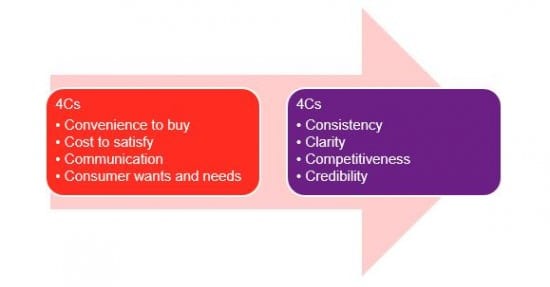
Lauterborn’s 4Cs: Consumer wants and needs; Cost to satisfy; Convenience to buy and Communication
What is it?
In 1990 Bob Lauterborn wrote an article in Advertising Age saying how the 4Ps (he didn’t address the 7Ps) were dead and today’s marketer needed to address the real issues.
He suggested ‘Consumer wants and needs’ as the focus on being product-led to companies making things customers didn’t want. A good example of this is probably Nokia, making lots of products, but failing to satisfy consumer needs and wants.
Need a plan to create a winning marketing strategy?
Get started today using a tried and tested step-by-step process to optimize your marketing.
Start Now
His second ‘C’ is ‘Cost to satisfy’ on the basis that price was irrelevant as so many other factors were involved. This is interesting if you consider commodity goods, such as non-brand purchases from supermarkets, where supermarket buyers are forcing down the price they pay with their suppliers. This is likely to be a contributory reason why horsemeat was introduced into ready meals – suppliers having to provide a ‘cost to satisfy’ buyers. The challenge for me is the perception of the terms ‘cost to satisfy’ with a company like Apple.
The ‘cost to satisfy’ sounds more like a lower price offer and Apple products are premium-priced. Perhaps that’s the key, as the cost to satisfy, for a brand like Apple, has to be higher than the competitors, to contribute towards the brand’s DNA as a luxury brand. Interestingly with Apple, taking an iPad Air 2 and looking at the ‘cost to satisfy’ (I really mean price here) across several different locations, the price seems to be universally the same.
The example taken is Apple iPad Air 2 (specifically the Apple A8X, iOS 8, 9.7", Wi-Fi, 64GB, Space Grey) sold at £479.00 at three different stores in the UK. This indicates that price is managed by the brand, to ensure discounting does not take place.

Example A - Apple iPad Air 2 – Prices on Apple.co.uk website = £479

Example B - Apple iPad Air 2 – Prices on Currys.co.uk website = £479
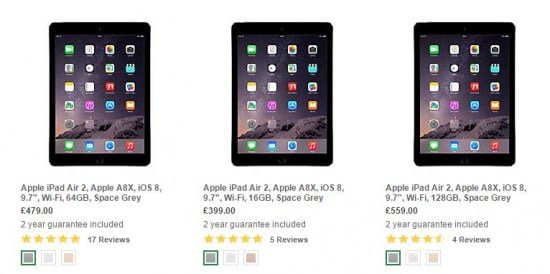
Example C - Apple iPad Air 2 – Prices on JohnLewis.co.uk website = £479
The third ‘C’ is ‘Convenience to buy’ and admittedly, the ‘P’ for ‘Place’ always felt tenuous as it’s really about access to the product and the letter ‘P’ worked in the alliterative set!
Convenience to buy is an interesting concept as we live in a 24/7 always-on world. The concept of shopping from 9am to 5pm, has gone. Although it’s not that long ago (perhaps 15 years) that I remember working in Italy and the shops closed during lunch hours too. And this included supermarkets – imagine the scene – you arrive at the supermarket at 12.45pm and at 1pm you haven’t completed your transaction, so you literally abandon your shopping trolley, in the store! Today trolley or cart abandonment is more likely to take place in the online world.
Core Module

Set up email nurture and retargeting
Part of the Email marketing and marketing automation Toolkit
Review the options for using email marketing to encourage conversions and sales
Learn MoreAdded to this, the development of disintermediation – giving shoppers the chance to remove the middle man and buy direct, as well as reintermediation – the middle men re-inventing themselves online, as Expedia has done (aggregating holiday offers in one place) or Skyscanner (all your flights for specific dates in one place) or the UK insurance broker ‘Compare the Market’ (bringing many car insurance policies to one screen, making it easier to compare). The advent of wearables takes the concept of buying ‘any place, anytime, anyhow’ to another level.
The final ‘C’ in Lauterborn’s 4Cs collection is communication. Lauterborn viewed promotion as manipulative and described it as a one-way system with communications pushed from company to consumer. His view of communication was that it should be about dialogue, a two-way conversation, between company and customer. Applying this in a digital sense, we can see customers creating communications through User Generated Content, so perhaps Lauterborn’s comments were an early insight into the changing nature of customer communication.
How can I use this model?
The 4 elements can be overlaid like a Venn diagram with the customer – or target market – at the centre of the circles.
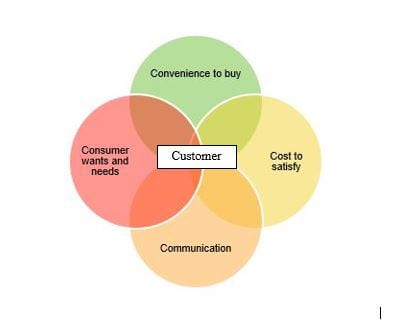
Each circle can be populated with details about where your company is now. What are its current 4Cs? How does this compare with your competitors’ 4Cs? What other action can you take to improve your 4Cs?
This useful template enables you to review your organisation using the 4Cs.
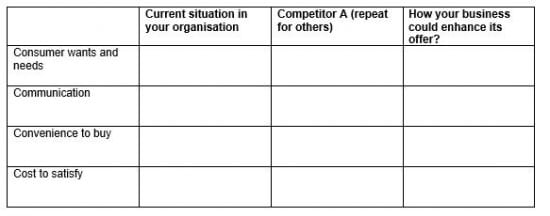
Applying this to Apple, it seems that there are aspects of the overall picture that are missing. Physical evidence, one part of the 7Ps, is a key factor in the Apple proposition. The look and feel of Apple products is an essential part of its marketing mix, yet the 4Cs doesn’t address this fully.
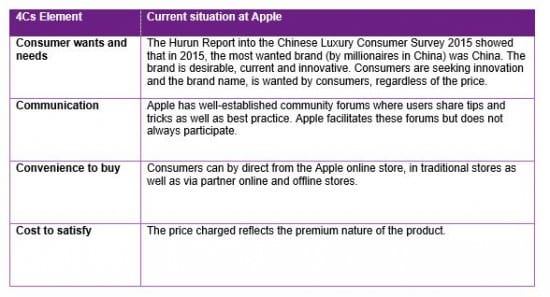
This is perhaps a less complex model to use and works well with smaller organizations.
What to watch for
This model may be too simplistic for larger organizations as its overall focus is narrow and excludes critical service elements such as people, processes and physical evidence.
For more on the original 7Ps of the marketing mix, click here.
Original Sources
Lauterborn, B. (1990). 'New marketing litany; four P's passe; C-words take over', Advertising Age, 41, p. 26, Expanded Academic ASAP, EBSCOhost, viewed 31 January 2015.
The 4Cs for marketing communications: Clarity; Credibility; Consistency and Competitiveness
What is it?
The 4Cs (Clarity, Credibility, Consistency, Competitiveness) is most often used in marketing communications and was created by David Jobber and John Fahy in their book ‘Foundations of Marketing’ (2009). Once a business has segmented its marketing and identified the target audience, the next stage is to position the business. To successfully achieve this, the 4Cs is a useful tool to create a positioning statement or to build an online value proposition.
Core Module

Define Digital Value Proposition
Part of the Digital marketing strategy and planning Toolkit
Learn how to craft a powerful Digital Value Proposition (DVP) and how this differs from a brand proposition
Learn MoreLooking at each of the 4Cs in more detail:
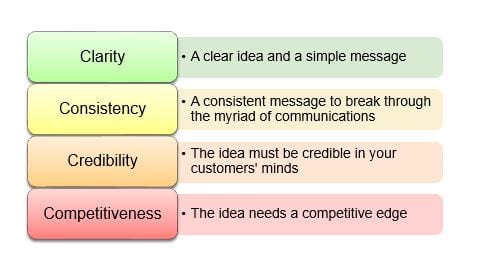
How can I use this model?
To understand how this works in practice, I’ve looked at four well-known companies and what’s interesting is that their slogans all meet the rules of Clarity, Credibility and Consistency. The Competitiveness element is less clear. And I am not sure how you would convey competitiveness with luxury brands.

Some UK supermarkets do address the Competitiveness element, for example:
• Morrisons’ slogan is ‘Love it cheaper’
• Sainsbury’s slogan is ‘Live well for less’
It seems when the competitiveness element is included, it’s about price, although it could also be about performance in B2B firms such as technology. Competitiveness is also about levels of customer service, such as Avis’s slogan (until 2012) ‘We try harder’.
What to watch for
It’s a great model to use when developing a slogan or online value proposition. Not all 4Cs will necessarily be used. It is essential that the slogan provides clarity (don’t make me think) and is credible. If it’s not credible, it won’t work.
Original Sources
Jobber, D. and Fahy, J. (2009). Foundations of marketing. 3rd ed. Published Maidenhead: McGraw-Hill Higher Education.
What's your preferred model? 7Ps or 4Cs? And how do you build your slogans? Do share with us!

Recommended Guide: Essential Marketing Models
In our free, illustrated guide to 15 classic planning models diagrams we explain what they are and give examples of why and how to apply them in business.
Download our Essential Marketing Planning Models guide.



























